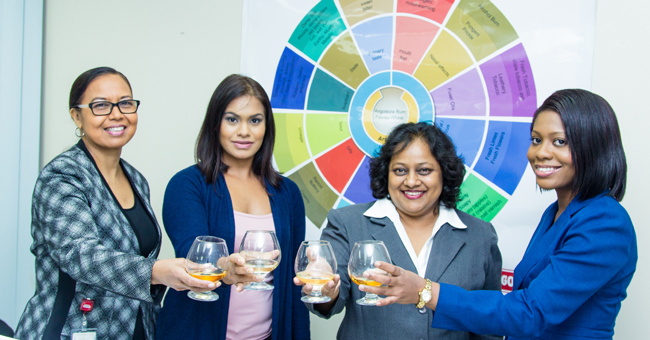We have Carol Homer-Caesar and her team to thank for Angostura’s award-winning new liqueur.
A Caribbean company creating its own take on Italian amaro? A pretty interesting cross-cultural venture, to say the least. But that isn’t the only reason we’re fascinated by Amaro di Angostura. Not only does Angostura’s latest release transcend cultures and geography—it was also developed by an all-woman team of blenders. Master blender Carol Homer-Caesar led a group of five over the last four years to create the new product based on the flavor profile of the company’s ubiquitous bitters.
Homer has been with Angostura for the last 20 years, moving from the laboratory into product development. “Blending is the next step,” she says. “We all have chemistry backgrounds as well as quality control backgrounds.”
 The Amaro di Angostura blending team, left to right: Carol Homer-Caesar, Amanda Khan, Sara Dookhoo and Narissa Joseph. Not pictured: Ann-Marie O’Brien.
The Amaro di Angostura blending team, left to right: Carol Homer-Caesar, Amanda Khan, Sara Dookhoo and Narissa Joseph. Not pictured: Ann-Marie O’Brien.
Beyond their professional bona fides, having a team of women working on the development of such a complex liqueur might make sense from a scientific perspective, too. As research published in 2014 by scientific journal PLOS One revealed, women have 43 percent more cells in their olfactory bulbs than men. Researchers from California and Brazil studied the postmortem brains of seven men and 11 women, none of whom worked in fields that would require an advanced sense of smell, and it revealed unequivocally that women have more cells in this specific area. This sharper sense is a trait women are born with, as very few cells are added to our brains over the course of our lives, leading the researchers to believe that it is a function necessary for reproductive bonding.
That it might have aided in the production of an award-winning amaro is a bonus. Homer-Caesar says that, in her experience, women do sense more subtle notes. While men can grasp the entirety of the flavor, women will taste and smell those elements in the product that aren’t very pronounced.
 All of the women on Amaro di Angostura’s blending team have backgrounds in chemistry and quality control.
All of the women on Amaro di Angostura’s blending team have backgrounds in chemistry and quality control.
Angostura publicly launched this first foray into amaro in February at the Clover Club in New York City. Amaro di Angostura is a sweet transformation of the house’s spicy, woody bitters into a smooth, usable liqueur. At this year’s Tales of the Cocktail Spirited Awards, it took home the Best New Spirit or Cocktail Ingredient award, beating out Rieger & Co. Kansas City Whiskey, Mister Katz’s Rock and Rye, and Suze Bitters.
This amaro is bottled at 35 percent ABV and is made with the same bespoke process that the House of Angostura uses for its bitters. The distillery’s yeast strain, which they’ve been cultivating since the 1930s, was blended with neutral alcohol and spices to create a tropical take on the classic liqueur.
The idea of creating an amaro had been discussed on occasion, but the company decided to launch it as a new product to celebrate their classic bitters on the occasion of their 190th anniversary, which passed in 2014.
To ensure precision in their sense appraisals of the new product, no one on the blending team wears perfume or can chew gum during the process. These appraisals are taken extremely seriously. Homer explains, “They’re done in a special room with special lighting. There are little booths, so panelists don’t see each other and don’t see color.”
 The blending team has spent the past five years in the lab developing the amaro.
The blending team has spent the past five years in the lab developing the amaro.
While working on this amaro blend, they tasted the competition in order to ensure that their blend would be special, even pitting it against Jagermeister and an Italian amaro in a blind tasting during a gathering of global bartenders at their headquarters. Of those who participated, 75 percent chose Angostura’s blend. “All our ingredients are natural. Our botanicals come from all over the world, and it’s very manual and labor intensive when we do our extractions,” Homer says. She, as the master blender, took on the responsibility of going into the Angostura headquarters at 6 a.m. during their testing phase to do appraisals while the building was quiet and empty, to focus solely on the blend.
Women have been rising in the blending ranks over the last twenty to thirty years. Joy Spence of Jamaica’s Appleton Estates became the world’s first female master blender in just 1997. Since then, the field has opened up. Organizations such as Ladies of American Distilleries provide resources and community, and with the explosion of artisanal distilling, more women are starting their own companies.
Homer “doesn’t want to be biased,” but she does believe women in the field “tend to be more passionate about blends.” According to her, “the depth and the romance that surround our alcoholic products come out in our art of blending. We tend to take more risk because we want to move to the next stage; we want to move farther.” Amaro di Angostura has proved a step in that innovative direction.





